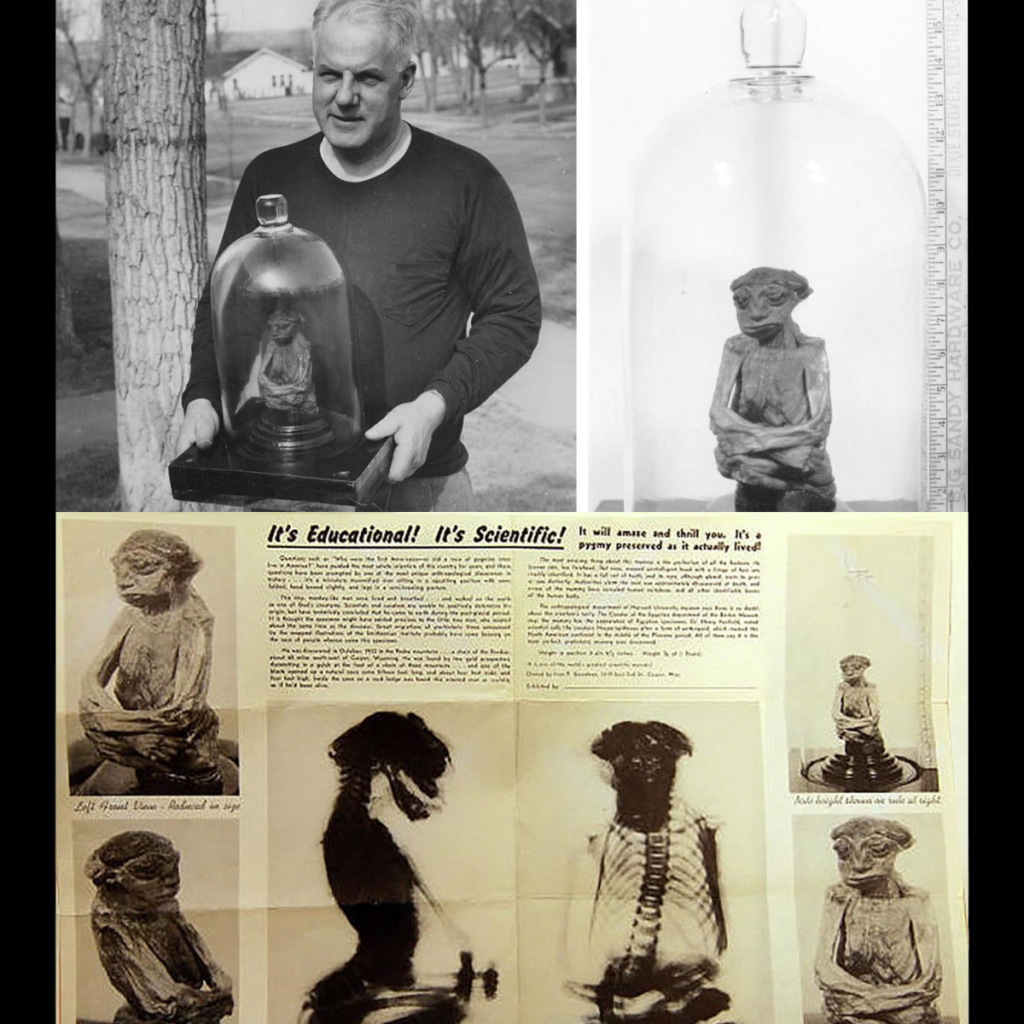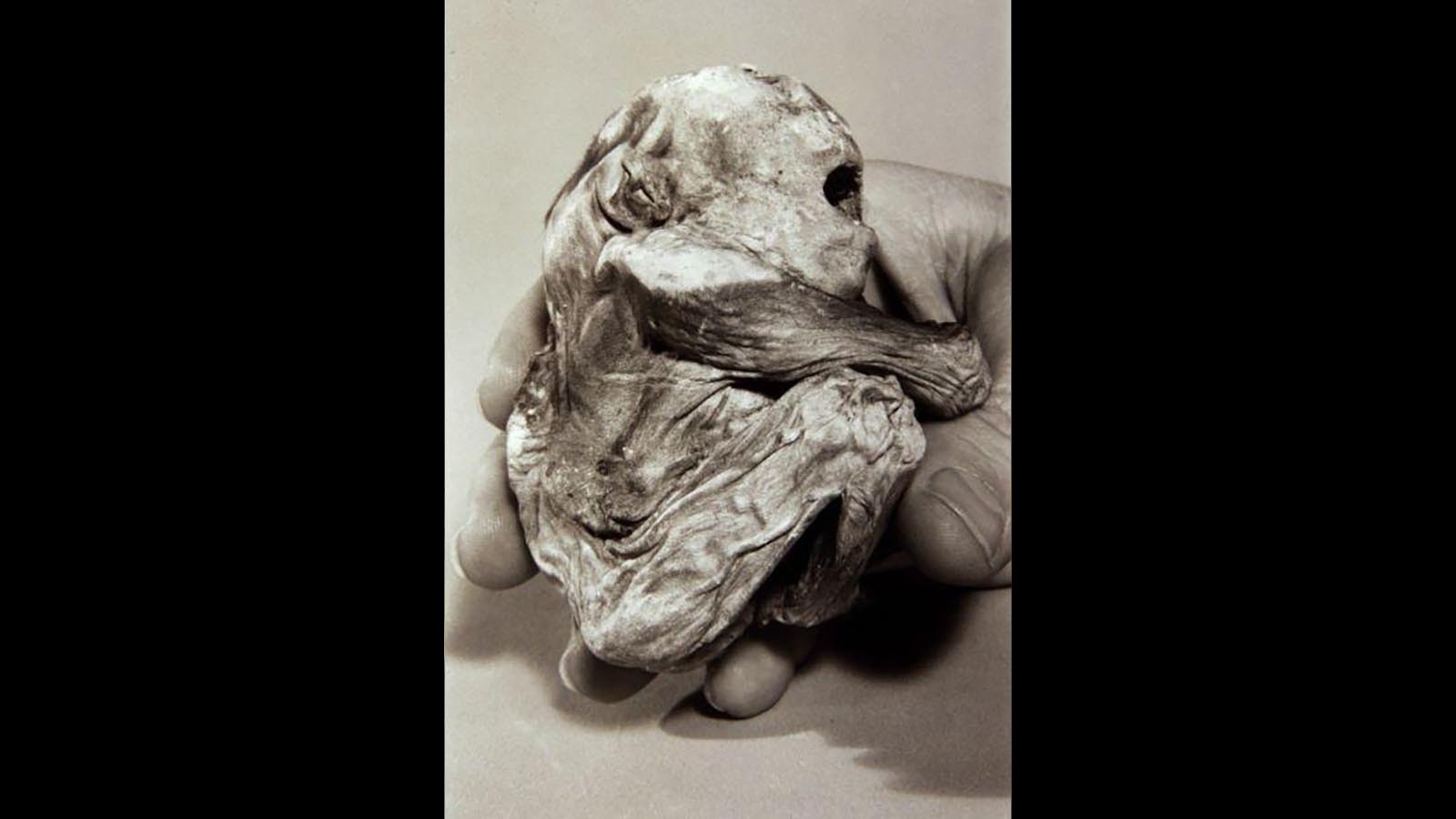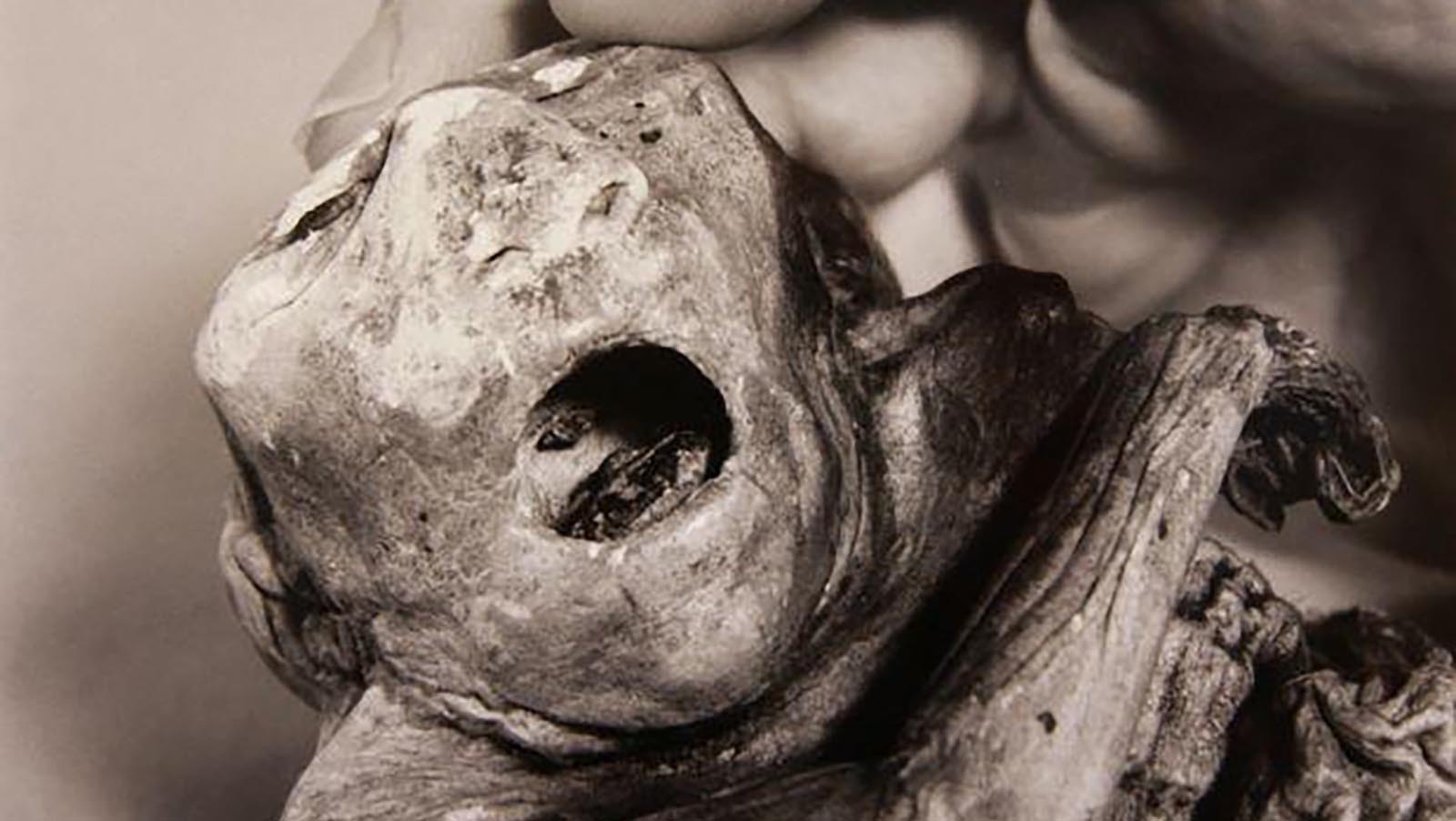

The odd story of a mummified mini-man found in a cave in central Wyoming is one of the most convoluted pieces of state history one could ever hope to unravel.
It’s filled with more dead ends, wild speculation and unbelievable implications than any tall tale told around a late-night campfire.
Tracing how this freakish artifact went from a potential history-changing discovery to nickel-ante sideshow to strangely disappearing is a saga where even basic facts like names and dates are fuzzy. It’s a story that raises more questions than it has answers.
Dozens of flawed, sensationalized and just plain incorrect archived newspaper accounts, books and television features exist about “Pedro, the Wyoming pygmy mummy.”
This account will at least attempt to clear up misconceptions, point out exaggerations and lies, and maybe reach a commonsensical conclusion. Though, be warned, the end is as perplexing as the beginning.
Some things are sure. A pair of bumbling amateur prospectors looking for gold instead stumbled upon the find of a lifetime. An archeological treasure initially declared a fake, later peddled as a cheap roadside attraction, and eventually lost to ages.
Oh, and also possibly cursed.
But here’s the thing, scoffers and unbelievers. The miniature mummy man was real. It wasn’t sewn together by carnival barkers looking to make a fast buck. It wasn’t hearsay or legend.
At least two exhaustive tests were conducted that confirmed the mummy was not a hoax, but genuine. The remaining mystery was whether “Pedro,” as he was known, was the result of an extremely rare congenital condition or physical proof of a mythical race of tiny people at the heart of American Indian lore.
The story begins in 1934. Or does it? The very premise has to be questioned since the date seems to meander around with each retelling. In still other sources, gold prospectors are confused with sheepherders, but there is a logical reason for that mix-up (more on that later).
Cecil Main (sometimes spelled incorrectly as Mayne) and Frank Carr were two amateur gold prospectors nosing around in the Pedro Mountains near Pathfinder Reservoir about 55 miles southwest of Casper. They set a dynamite charge and blasted open a portion of a side hill hoping to uncover an ore vein.
Instead, when the smoke cleared, a small chamber was revealed, barely big enough to be called a cave.
Main shimmied into the cavern. Inside was empty until he shined his light on a ledge a couple feet off the ground. Staring back at him was a wizened Buddha-like man with bugged out eyes seated upright in a lotus position. Its skull appeared to be flattened, the face twisted into a sardonic grin.
Imagine Main’s initial shock.
He snatched the tiny mummified man, sensing its uniqueness alone would have to be worth something. It was maybe 6 ½ inches tall sitting. Probably not 17 inches if it was standing upright. It weighed a little over a pound.
When the two showed off their discovery in Casper the following day, they were reportedly ridiculed for trying to peddle such nonsense. It is also there in Casper where the story first goes off the rails.

Dubious Dates
An article in the Casper Tribune-Herald dated Oct. 21, 1932, heralded the finding.
Years later, several follow-up stories, including one in the Casper Star Tribune dated Nov. 30, 1934, also mentioned the discovery of the little mummy as happening in October 1932 in a story headlined: “Mummy Found Two Years Ago in Pedro Mountains Is Puzzle to Science Today.”
Yet in a sworn affidavit given on Nov. 13, 1936, Main claims he and Carr found the mummy in June 1934. Strange.
It would presumably be easier to assume Main was mistaken about the date than to believe two different newspapers in Casper got it wrong. How could the Tribune-Herald know of a mummy discovery that had not yet happened?
Main also claimed at that time of the affidavit that he no longer was in possession of the mummy, having sold it in April 1934 to a man named Homer F. Sherill of Crawford, Nebraska, who subsequently loaned it out to the Field Museum in Chicago, Illinois.
Current museum archivist Armand Esai said there is no record of the mini-mummy being displayed during that time but admitted it could have been an undocumented holding.
However, a man named Paul Martin did examine the mummy on the museum’s behalf in 1950.
Confused yet?
Pedro Goes On Tour
Carr died shortly after the discovery (a curse of the mummy?) so he exits the story. Main, meanwhile, never manages to monetize the mummy referred to as “Pedro” for the mountains it was found in. Too many people don’t believe him.
According to old newspaper clippings, Pedro was the “center of controversy, locally, for years.” Some denouncing it as a hoax, others conjecturing it could be proof of a race of little people, or Nimerigar, a longstanding bit of folklore of the Shoshone.
According to legend, the Nimerigar were an aggressive people possessing great strength who would shoot poisoned arrows from tiny bows. The Shoshone also believed the Nimerigar would kill their own people with a blow to the head if they became too ill to be a participating member of society.
Sherill may not have put Pedro in the Field Museum, but he did likely own the mummy for at least seven years, making a buck or two exhibiting the freakish artifact to passing motorists.
Eugene Bashor remembers seeing the mummy as a roadside attraction in Casper in 1936. The 10-year-old begged 25 cents out of his father for a hurried look at it inside a tent. The experience left him with a lifelong ambition of learning more about mini-mummies and the possibility that they could shed light on little people legends.
Bashor was featured in a 1994 episode of “Unsolved Mysteries With Robert Stack” that included the fascinating story of the “Mystery Mummy.”
From Sherill, Pedro made his way somehow to Floyd Jones, who put the oddity on display in his drug store in Meeteetse. A man named Ivan Goodman spotted the mummy there in the mid-1940s and thought it would look better at his car dealership in Casper. He bought it for a reputed “several thousand dollars.”
Goodman used Pedro’s eye-catching appearance to attract people to his car lot. By then, Pedro was seated on a wooden platform and encased under a glass dome.
As an unofficial mascot of sorts, the enterprising salesman also placed newspaper ads proclaiming:
“It’s Educational! It’s Scientific! It will amaze and thrill you. It’s a pygmy preserved as it actually lived!” and, “This pygmy was 65 years old when it died,” the poster claimed.

Tiny Mummy Examined
The purported age of 65, along with other unsubstantiated claims, began appearing in the late-1940s. Their source is difficult to pinpoint. Some of it could have come from an outrageous tabloid piece in the Milwaukee Journal (Aug. 17, 1941) headlined: “Did a Race of Pygmies Once Live in America?”
In the story, the Journal reported an X-ray of the mummy showed raw meat in the stomach and teeth in the front of the mouth “pointed and of the flesh-eating variety.”
What X-ray the Journal referred to is not clear. Pedro would not be examined until the late 1940s when Dixon Goodman confirmed his father brought the mummy to Dr. Harry Shapiro, curator of biological anthropology at the American Museum of Natural History in New York City, to ascertain whether it was real.
Shapiro performed an extensive month-long examination — as thorough as could be done at the time. X-ray images proved the mummy wasn’t a fake. Its flesh stretched over a skeleton, with visible vertebrae, rib cage, and arm and leg bones.
Shapiro’s findings did not include anything about the mummy’s age, injuries to the skull nor spine, or pointed teeth. Yet those rumors persist to this day.
Shapiro did, however, leave the door open for speculation.
“If the mummy is that of an adult, it is smaller than dwarf types now known as midgets and pygmies,” Shapiro was quoted as saying in a Berkshire County Eagle (Mass.) article dated March 4, 1950. “I can only say that of this little thing is a human adult, it would be the first evidence of a race of little men on this continent I have seen.”
In a Casper Tribune-Herald story dated March 5, 1950, the newspaper claimed: “The study confirmed that Pedro was not a fake but did indeed contain a complete if minuscule skeleton, a fully-fused skull, plus a full set of teeth.”
In the same newspaper account, Goodman, not Shapiro, is quoted as saying, “After an exhaustive study by the scientists it was agreed that it was the only specimen known of a human race of that type which perhaps dated back a million years.”
In reality, Shapiro’s findings, along with Dr. Martin’s in 1950, concluded the mummy was almost certainly a human baby, either stillborn or dead shortly after birth. The child probably died of anencephaly, the congenital absence of a large part of the brain.
Numerous online renditions of the narrative have Shapiro sharing his research with the University of Wyoming, where anthropologist professor George W. Gill concurred. Gill would later review Shapiro’s work, but in 1950 he was in elementary school.

Mummy Disappears
Goodman returned to New York City later in 1950 where he somehow lost the mummy. Three newspaper reports claim Goodman sold or loaned Pedro to Leonard Wadler for research purposes. Goodman took ill and died soon after.
Wadler himself was an unusual character. He ran what he called the Cultural Resource Center — a lonely hearts club proponent of remaining single against urges to marry. The Yeshiva College graduate had no known expertise or contacts in the area of anthropology.
Wadler later moved to Florida and reportedly gave private showings of the mummy as late as 1975. He died in 1980.
Wadler’s family was contacted about the artifact and claimed to know nothing of it. There is no mention of Pedro after 1950. The mummy simply vanished.
If the mummy ever turns up again, it would be subject to the Native American Graves and Repatriation Act as it is almost certainly the body of an American Indian child taken from a grave.
Chiquita Makes The Scene
Interest in the mummy remained strong through the decades. When professor Gill was hired by UW in 1971, his class urged him to look into it. Gill did so finally in 1994, when he was asked to appear on “Unsolved Mysteries” to talk about Pedro.
Gill concurred with the findings of Shapiro and Martin, that the mummy was likely that of a malformed infant.
“Some serious efforts were made in the 1950s to get this mummy documented and it was done rather well for the times, I think,” Dr. Gill said during an interview on the show.
Gill added that DNA testing today could be done to determine ethnicity, and less invasive carbon dating could pinpoint an age.
As a result of the popularity of the show, a Cheyenne family brought Gill another mummy, which they said their grandfather bought from a sheepherder in around 1929 in the Pedro Mountains area.
Similar to Pedro, the mummy was tiny — the size of a large potato. It was balled up and rock hard, but distinctly humanlike. It had notable blonde hairs protruding from the scalp.
The family put strict terms on Gill’s access to Chiquita, as Gill named it. He examined it only three distinct times and was never allowed to keep it overnight.
Gill also arranged for tests at the Children’s Hospital in Denver. The results confirmed his suspicions — a baby born with anencephaly that would not have survived long.
He and his research assistant, Maxine Miller, also said the infant was a Native American and confidently dated it to about 1700.


Little Mummies, Not Little People
Yet both Pedro and Chiquita were buried in such a way that they were preserved from the elements, left undisturbed to mummify naturally in Wyoming’s arid climate. Both were left to posterity with their legs tucked under them, arms wrapped around themselves. Upright.
“Nowhere else in Wyoming do we have burials sitting up like that. Never sitting up with legs crossed and arms folded across their chest. There’s a clear connection between the two of them, besides being in the same region,” Gill said. “It’s something I haven’t seen in the hundreds of prehistoric burials I have examined, so it is obvious that these infants were handled in a special way.”
Gill said the discoveries were not proof against pervasive rumors that still exist throughout Wyoming. They just were not members of a prehistoric tribe of “little people” that persists in Crow and Shoshone legend.
“Anencephalic infants often look like little adults. They are thin, and because they haven’t developed brains, they exhibit the adult proportion of skull and face to body size, thus resembling tiny adults,” Gill added.
Still, the discovery of a malformed infant mummy — and not just one, but two — is exceptionally rare. Only one other such mummified anencephalic infant is known to exist in the world. That one found in an ancient Egyptian tomb.
Little has been written about the mummies in some time.
In 2005, John Adolfi of Granby, New York, offered a $10,000 reward for the mummy, claiming it could disprove the theory of evolution. Adolfi’s reward has remained unclaimed.
